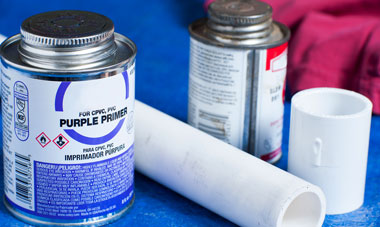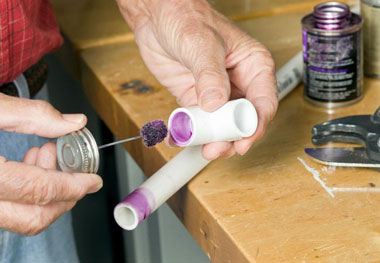PVC primer is one of the best adhesives you can use in your PVC piping applications. Do you know why? First, it’s because the primer is easy to apply, and secondly, it sets in minutes.
But what does PVC primer do? It simply softens PVC, thereby allowing your PVC pipes and fittings to cement securely. As a result, this helps ensure the maximum durability of your pipe joints. Besides that, the primer helps clean the PVC surface off dirt, grime, and grease.
But that’s not all. So, keep reading to find out what else PVC primer does, how to apply it, and how long you should let it sit.

What Does PVC Primer Do?
Not sure whether or not to use PVC primer for all of your joint connections? Well, below, you can find out what exactly PVC primer does.
Strengthens pipe joints
Typically, you apply PVC primer to the joint connections between your PVC pipes. Consequently, this helps maximize the strength and durability of your connections, thereby ensuring leak-free connections.
But how does this work? Once you apply the primer to the joints, it usually softens PVC surface through a chemical reaction. As a result, the cement bonds the two PVC surfaces strongly.
Cleans PVC surface
When fitting PVC pipes, you must ensure the PVC surfaces are clean. If, after cleaning the pipes, there are still some traces of dirt, PVC primer can clean all of it. Because as it turns out, the primer is designed to clean the PVC surfaces, including stubborn grime, chemically.
Expedites inspection process
You must use purple PVC primer for industrial applications instead of the clear one. It makes it easy for a building inspector to tell whether or not you used PVC primer while fitting PVC pipes. This is because, in most states, inspectors are required by the law to conduct a visual check of each joint.
Helps paint adhere better
When painting your PVC pipes, a PVC primer can help ensure the paint adheres better. However, you must first sand your PVC pipes before applying a coat of primer.
How Do You Apply PVC Primer?
PVC primer can be quite messy when using it for PVC connection. But if you know how to apply it correctly, you won’t have to deal with any mess. Below is a step-by-step guide to help you.
Step 1: Gather your materials
You need a couple of things, including PVC primer, pipe cutters, PVC cement, and clean cloth rags. And of course, you will need pipes and fittings.
Step 2: Cut the PVC pipes
Next, cut your PVC pipe square according to your desired length using your pipe cutter. Then, remove any internal and external shavings to ensure smooth ends.
Step 3: Clean the PVC surfaces
Using your clean rag, wipe any accumulated dirt, grime, or grease off the surfaces of the pipe and fittings.
Step 4: Apply the primer
Next up, apply a coat of primer on the surface of your fitting socket, keeping it wet until it is softened. After that, quickly apply another coat to the outside of your PVC pipe.
Step 5: Apply PVC cement
After priming, wait for around 10 seconds and apply your cement while the fitting and PVC pipe surfaces are still wet. Start by applying the cement on the outside of your pipe and then inside your PVC connection.
Finally, join your pipe and fitting while the cement is still wet and hold them together for at least 30 seconds.
Is PVC Primer the Same as Glue?
The simple answer is no, even though they have the same active ingredient, tetrahydrofuran. The difference between these two PVC adhesives is that PVC primer acts as a cleaner. Besides that, it softens PVC pipes and fittings while strengthening the pipe joints.
On the other hand, PVC glues are designed to permanently bond two PVC parts together. Consequently, this usually makes the two parts difficult to separate unless you cut the pipes. Another difference is that, while you can use glue alone when connecting PVC fittings, you cannot do the same with PVC primer.
How Long Do You Let PVC Primer Sit?
Once you have applied the primer, you should hold your joint connections for at least 30 seconds. Then, allow the primer to sit for around 15 minutes. This time is enough to give your PVC good handling strength.
But overall, you should leave the primer to sit for 2 hours to cure completely. This should happen at a temperature above 60-degrees Fahrenheit. After 2 hours, your pipes will be strong enough to withstand high water pressure.
Read More: Best Ways To Secure PVC Pipe To Wall
What Is the Difference Between Clear and Purple PVC Primer?

Both primers are designed to do the same thing: connecting PVC pipes and fittings securely. But because of their color differences, purple PVC primer is best suited for commercial applications. This is because it is easier to spot during a routine inspection by a building inspector.
On the other hand, Clear primer is ideal for residential use where aesthetics are very important. This is because it leaves your joints clean and tidy.
How Do You Remove PVC Primer Stains?
If you accidentally spill PVC primer on other surfaces, here are simple ways to remove the stains.
Use clear PVC primer or cleaner
This method works if you manage to catch the spill early enough. You simply apply a PVC cleaner or clear primer on a cotton swab and gently pat the stained surface.
Make baking soda paste
Simply mix baking soda and water in equal parts to form a paste. Then, apply the paste to the stain and rub the surface with a sponge. Be sure to use the rough side of your sponge.
Using acetone or methyl ethyl ketone
Both of these liquid solvents are active ingredients in PVC primer. Therefore, you should use them with care. For acetone, you can use any nail polish remover as long as it is acetone-based.
Conclusion
PVC primer is an essential product to use when fitting PVC pipes. This is because it helps enhance the strength of your PVC fittings. As a result, you don’t have to worry about leaks as much. You can also use the primer as a cleaner for your PVC surfaces.
The best part about PVC primer is that it is easy to apply with just a brush. On top of that, it only takes around 2 hours to cure completely, which is a short time. You will also love that primer is easy to remove if it spills on other surfaces. This is especially true if you catch the spills early.